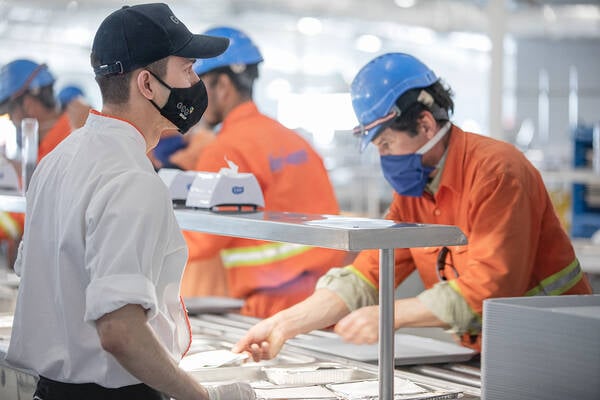Managing a global workforce across different regions in 2020 was no easy feat. With personnel stretching from China to Uruguay and with employees based in offices as well as in mills and construction sites, UPM Pulp has long understood how to optimise different types of work processes.
This year, however, saw a number of changes, including new safety protocols and digital upgrades to keep face-to-face contacts to a minimum.
These changes for personnel also took place at a time when the industry was adjusting to different flows in supply and demand for products. Looking ahead to the future, many of these adaptations are likely to remain as the company continues to develop operations.

New safety protocols were added in facilities this year to keep employees safe.
Photo credit - UPM
More digitalisation
Many office-based employees were already using digital tools to connect, but this year virtual meetings came into daily operations in pulp mills as well.
“The daily production and maintenance meetings are now being run virtually through Teams,” explains Minna Palho, Director, HR, Finland Pulp Operations. “This has been done face-to-face for years in a big meeting room, but now people participate from their own departments and this saves a lot of time.”
Going forward, operations will be conducted through a mix of virtual and face-to-face options, taking into consideration the best options for the situation. While some in-person contact will resume in 2021, online meetings offer possibilities for nearly all aspects of the business.
“In general, we have learned new ways of working in an agile way. The virtual collaboration at mills has been positive,” says Palho, noting that virtual training and onboarding programmes have also been well received.
But when innovating and creating something new, face-to-face clearly works better, says Palho, so in the future, the company will not rely solely on digital solutions.
“The new normal is still emerging, but the idea going forward is to pick the best parts of how we used to do things with what we have learned, and combine the in-person and virtual,” Palho says.

Demand for tissue products, particularly in Asia, is expected to grow next year.
Photo credit – Hanson Lu, Unsplash
Supply and demand
The company also continues to adapt to changes in market pulp demand across the industry in this volatile market.
“At the industry level, all eyes are on the demand and seeing how that develops in different parts of the world,” says Laura Lundell, Pulp Strategy Manager at UPM.
Asia continues to be a promising market for pulp in tissue paper end use in particular. She notes that while tissue and hygienic papers have been in demand globally this year, Western markets for these products are already mature. Tissue paper consumption can be measured in kilogrammes per person per year. In the US, the rate of use is approximately 26 kg per person per year. In Western Europe, it is 16, but in China, it is still under 10 kg per person per year.
“The strong demand for tissue paper in Asia is something that everyone is keen on understanding. It’s not a question of whether there is growth or not, but how fast and how much,” Lundell says.
Overall, the long-term demand drivers for the pulp industry are strong. Urbanisation and middle-class growth support the demand for pulp in end uses, such as packaging and tissue products, and both of these trends should continue to expand. According to the UN, 68% of the world’s population will live in cities by 2050 and the Brookings Institution projects 4.9 billion will be considered middle class in 2030, up from 3.2 billion in 2020.
Following up on demand development is a crucial part of industry understanding, but another part is understanding the development of supply. UPM will start a new pulp mill in Uruguay in 2022. There are some other pulp mill projects that are scheduled to come online about the same time, changing market dynamics further.
With the pace of technology accelerating and consumer markets shifting, the pulp industry of the future may look different than it has in earlier times, but the past year has shown the ability of UPM Pulp to be agile. Looking ahead, the company seems prepared to go where the market leads and adapt successfully.
Text: Lara McCoy
